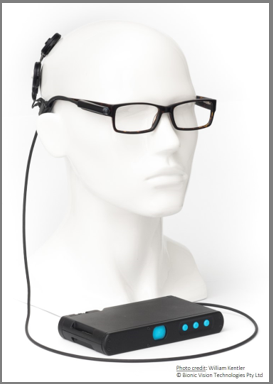Device for retinitis pigmentosa safe at two years, restores some functional vision and visual function. Howard Larkin reports.
Presenters at the Association for Research in Vision and Ophthalmology 2021 Annual Meeting reported a 44-channel retinal prosthesis safe after 24 months (NCTNCT03406416). The device—which was placed in the suprachoroidal space in four patients with advanced retinitis pigmentosa—also improved patient performance on functional vision and visual function tests.
In the 24 months after the uncomplicated implant surgery, all four patients showed only minor movement in their optical coherence tomography (OCT) imaging, most of which was rotational. The most significant rotation was up to 17 degrees in one eye, but it did not affect device function, according to Penelope Allen MBBS, FRANZCO, Associate Professor and Vitreoretinal Surgeon at the Centre for Eye Research Australia, East Melbourne. OCT, fundus photography, and clinical exams all confirmed the location of the devices behind the patients’ macula and the absence of retinal trauma. No serious adverse events occurred during two years of follow up.
The study builds on a previous device (NCTNCT01603576), adding 20 channels and a wider field of view to the current device. The aim was to develop a bionic eye usable at home and safer—and easier—to implant when treating people with inherited retinal disease, Dr Allen said.
“The devices are stable after an initial settling period. The arrays remain functional, and we believe this is due to the stability of the surgical approach.”
FUNCTIONAL GAINS
After 16 weeks of vision rehabilitation training, the patients were assessed on three laboratory-based visual function tasks and three functional vision tests, said Maria Kolic, orthoptist and senior clinical trial coordinator at the Centre for Eye Research Australia. With the device on, three of the four participants could discriminate moving bar speeds ranging from 7 to 30 degrees per second. Average pointing error across all visits on square location was significantly less for all four participants, at 10.3 ± 3.3 degrees with the device on versus 27.7 ± 8.7 degrees with the device off. Two of the four participants had measurable grating acuity of 0.033 cycles per degree. On average, the device improved participants’ ability to locate objects on the table-top search, detect and touch the doorway on the doorway detection task, and detect and avoid more obstacles during obstacle avoidance task.
On the real-world Functional Low-Vision Observer Rated Assessment instrument, all four participants showed improvements with the device on compared to off; and the three participants who continued follow-up appointments showed increased improvement, particularly within the first six months, and they held stable for the remainder of the two-year trial, reported Lewis Karapanos MD, also of the Centre for Eye Research Australia. Participants also self-reported improvements in mobility, functional vision, and quality of life.
The Australian National Health and Medical Research Council and commercial partners Bionic Vision Technologies funded the research.


Penelope Allen: pjallen@unimelb.edu.au

Maria Kolic: maria.kolic@unimelb.edu.au


 Penelope Allen: pjallen@unimelb.edu.au
Penelope Allen: pjallen@unimelb.edu.au
 Maria Kolic: maria.kolic@unimelb.edu.au
Maria Kolic: maria.kolic@unimelb.edu.au